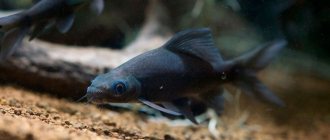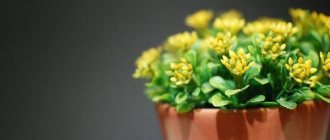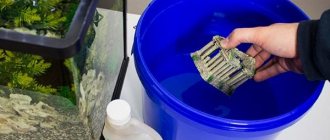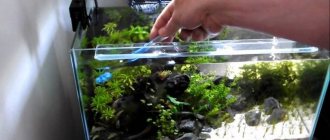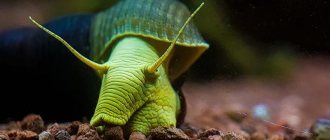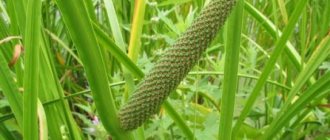Beginning aquarists, when purchasing an aquarium, often wonder whether to buy an aquarium with a lid or without? Indeed, when you come to the store, you can notice that some aquariums come complete with a lid, some with a cover glass, and some even without it. Let's try to understand this issue in detail.
Among the main advantages of having a lid on an aquarium are the following:
- Prevents dust from entering the aquarium
- Does not allow the inhabitants of the aquarium to leave it
- Reduces the amount of water evaporated
- Serves as a mount for aquarium lighting
Prevents dust from entering the aquarium
When operating an aquarium without a lid, dust and various objects will inevitably get into the water, which not only spoil the appearance of the corner of the underwater world, but can also affect the health of its inhabitants by polluting the water. If the aquarium is placed in the kitchen, then fat and various fumes that enter the air during cooking will settle on the surface of the water, forming a film.
In addition to dust, various objects can get into the aquarium, especially if you have children living in your apartment. And if you have pets that roam freely around your apartment, then an aquarium cover is a must. Firstly, because cats usually have an undisguised interest in fish and aquariums. Secondly, the pet may fall into the water and die.
If your aquarium is large enough, then not only an animal, but also a child can fall into it. In this case, having a lid on the aquarium is a safety issue.
What kind of soil does an aquarium need?
Aquascape soil can be neutral and nutritious. Neutral soil is a substrate that is not enriched with useful substances or fertilizers. It absorbs remnants of vegetation, waste products of fish, and leftover food. Without a neutral substrate, all waste and contaminants will float in the water, which will lead to rapid pollution and cloudiness of the water, as well as the formation of algae.
Neutral substrate is used to decorate aquascapes and collect garbage. This is coarse sand, quartz, pebbles. They themselves do not bring any benefit to the greenery. If the aquarium uses a neutral soil base, it is necessary to additionally fertilize the water with special plant feed additives.
To plant vegetation, you need to buy a nutrient base. This is a large group represented by natural and artificial species.
Nutrient substrates
Soil for plants is laid out on the bottom of the tank in a thin layer. It contains many useful substances that greens need for normal growth. The soil transfers nutrients to greenery through the root system. Vegetation must be planted directly into the nutrient base. The recharge is covered with a layer of neutral substrate, which has a decorative function.
The composition of the recharge may include a large number of useful substances. The composition depends on the manufacturer. You cannot use only food substrate in an aquarium with water. It will constantly wash out and pollute the reservoir.
Substrates can be:
- lateritic: contain a lot of iron;
- clay: contain a lot of potassium;
- peat: contain a lot of phosphorus and nitrogen.
The choice of substrate depends on the type of vegetation. It is better to find out in advance in the store what kind of soil your green spaces need.
Earthen or natural soil
A natural substrate is not just soil that is placed in a tank. These are special granules that can be used without a neutral primer layer. The granules contain a lower concentration of useful substances than the substrate, so there will not be an excess of components in the water. The granules are durable, so they are practically not washed out with water.
The lid prevents the inhabitants of the aquarium from leaving it
It is quite a common occurrence for aquatic organisms to die as a result of an attempt to escape from the aquarium. There can be many reasons for this, ranging from unsatisfactory water conditions to fear as a result of sudden movement near the aquarium. Very often, as a result of this, the animal dies, because, unfortunately, it is not always possible to notice and return the fugitive to the aquarium in time.
Not only fish, but also other inhabitants of the underwater kingdom can fall out of the aquarium. For example, ampullaria snails lay their eggs not in water, like many mollusks, but on land. If the aquarium does not have a lid, the snail may leave the aquarium to lay eggs, and then die due to the fact that it could not return to the water. Also, ampularia can breathe atmospheric air, so quite often they can be seen on the glass of an aquarium above the water level. If a resident of your aquarium decides to leave his usual habitat, then the lid will stop him and save his life.
Do-it-yourself soil for an aquarium
It is not necessary to buy a ready-made substrate in the store; you can use natural materials and make the substrate yourself.
The substrate can be made of sand, clay, laterite, peat. Sand is a natural substrate that is suitable for most plants. Sand is mixed with fine gravel and placed on the bottom of the tank. Gravel holds plant roots, and middle sand contains iron. Additionally, sand is mixed with peat, clay or shell rock to increase the concentration of beneficial substances.
Fine-grained sand should not be used for planted aquariums. It contains no useful substances, it is quickly washed out and pollutes water, clogs and damages equipment. It is better to buy sand in pet stores.
Clay contains iron, copper, manganese, aluminum and other components. It all depends on the type of clay. Clay attracts metal particles and salts, making it a good substrate for vegetation.
Laterite is a tropical earth that contains iron. Laterite is placed at the bottom of the tank, and a neutral substrate is lined on top. It absorbs all the beneficial substances from the aquarium and water, creating an excellent food base.
Peat reduces water hardness and contains many useful minerals. It contains a lot of humic substances. It is added in pure form or mixed with sand.
Garden soil is not suitable as a substrate for an aquarium with plants. It contains many useful substances, but it is too dirty for the aquatic environment. The aquarium will quickly become filled with algae. Garden soil can be used as a substrate along with sand, peat, gravel.
Reduces the amount of water evaporated
The process of evaporation of water from the aquarium occurs constantly. This is influenced not only by the air humidity in the room, but also by the surface area of the water. As a result, the concentration of salts and heavy metals in the aquarium increases and the composition of the water changes. This can be a serious problem if you need to go away for a while and leave the aquarium unattended.
In addition, increased humidity in the room as a result of water evaporation can lead to peeling of wallpaper, the formation of fungi and mold. The lid on the aquarium allows you not to think about such problems.
Aquarium according to Feng Shui: basic rules
Have you decided to install an aquarium according to Feng Shui? If you are not strong in aquarium keeping, use the services of specialists who will organize the proper operation of the aquarium for you, and will also periodically come to check its condition, clean and care for it.
Feng Shui aquarium
Goldfish are a sign of abundance in many cultures. I would like to give an example of our fairy tale about the golden wish-fulfiller, but Alexander Sergeevich simply rewrote the interpretation of a Chinese fairy tale.
The size of the aquarium should not be too large compared to the area of the room where it is located. Otherwise, it will flood the areas you were planning to activate.
Keep the water in the aquarium clean and do not forget to take care of your pets, thus attracting money. Clean water, healthy fish and plants are all important.
The lid serves as a mount for lighting the aquarium
In most cases, aquarium manufacturers build a light into the lid. This is quite convenient because you don’t have to purchase it separately. Sometimes you can find aquarium covers with a built-in filter, timer, and even an automatic fish feeder. This is especially convenient if the aquarium is purchased as a gift, because in this case it is a complete device that does not require additional costs other than the purchase of fish, soil and plants.
It would seem that aquariums with a lid have continuous advantages. In fact, this is far from the case. The disadvantages include the following:
- Inconvenience of service
- Weak built-in lights
- Strong heating of lamps
- Interferes with equipment installation
Materials and decorations
All materials and decorations are natural
Priming
- Sand ADA La plata sand fine (neutral). Later, ordinary quartz sand with a fraction of 1-2mm was added.
- In some places, nutrient soil (soil) is used in wabi kus and coconut pots
Stones
- Volcanic lava is brown in color. Increases carbonate hardness by 3-4 degrees
driftwood
- Roots of coniferous trees from forests near Moscow
Water
100% purified by reverse osmosis filter. No remineralizer is added. To mineralize osmotic water, minerals from lava are sufficient
Inconvenience of service
As you probably know, aquariums require regular maintenance. Of course, manufacturers carefully provide a small hatch in the lids for feeding fish, but this is not the intervention we have in mind. Don't forget about regular aquarium maintenance.
From time to time you will need to remove uneaten food and dead plant leaves from the aquarium. And once a week you will wipe the glass, siphon the soil and change the water. All this cannot be done without removing the lid every time. Moreover, the lighting in the lid requires a connection to the power supply, so it is not a fact that you will be able to remove it without pulling the plug out of the socket. This is very inconvenient and makes caring for the aquarium difficult.
Types of store soils
There are a large number of aquascape substrates sold in stores. Branded soil substrates are designed taking into account the needs of vegetation, they contain a sufficient number of useful components so that they bring maximum benefit.
The most popular substrates are produced by Tetra, Aqua, JBL, Aquarel, Estes, Euragurium.
Aqua Plants nutrient soil is developed for the vegetation of South America and Africa. The substrate lowers the acidity level, makes the water softer, and helps recreate the natural biosphere for tropical greenery.
Nutrient soil Jbl Manado is a useful substrate that contains the main components for the growth of vegetation: peat, clay, iron, plus mineral supplements. The granular substrate disinfects water, destroys harmful bacteria, and is used as a substrate. 2-3 cm of substrate is enough in the tank to provide the vegetation with useful substances.
Weak built-in lights
Lamps built into the aquarium lid are usually very weak. They are so weak that they are barely enough for even the most unpretentious plants. Growing some kind of ground cover, for example, is out of the question. With such lighting, the aquarium looks very bad, and you most likely will not be able to replace the lamp in the lid with a brighter one.
Pond plants
The main criterion when choosing such plants is their size. The biology of the species is also of no small importance, since many plants in the temperate climate zone are characterized by a dormant period (winter), which is difficult to simulate in an apartment. Therefore, such plants are difficult to grow in riparium .
Tropical and subtropical species are the best choice, but even these plants have a dormant period during the dry season, which can be created by placing the plant in a cool, dry place for several months.
Mexican Petunia (Ruellia brittoniana)
This is a very decorative crop that has two forms: a vertical “bell-shaped” one, reaching up to 120 cm in length, and a similar natural form. Dwarf varieties of this species, 30 cm in length, have been obtained.
Mexican petunia flowers come in pink, bright blue and purple colors. This unpretentious plant is often used in landscape design, both for decorating garden ponds and for growing in moist soil.
Ruellia brittoniana
Mexican petunia grows well in riparium , and when optimal conditions are created, it can bloom. To create the composition, the tall bell shape is trimmed and tied to various objects.
A disadvantage of the culture can be considered high susceptibility to spider mites. In case of infection, treatment is necessary by placing the plant in a container with a solution of isopropyl alcohol.
Zephyranthes sp.
Zephyranthes is a beautifully flowering perennial bulbous plant. In nature, they are common in the tropical regions of Central and South America, as well as on the islands of the Caribbean. Zephyranthes grows in floodplain swamps. Flowers last only 1-2 days, then new ones appear instead.
The genus Zephyranthes includes about 40 species of bulbous plants.
Zephyranthes
There are many species and varieties of the genus Zephyranthes in cultivation. Quite sparse foliage, compensated by stunning blooms, white or pink flowers. All types and varieties grow well near ornamental ponds. Sometimes there are species that do not grow well in wet soil.
Being dormant during the dry period, the plants begin to actively bloom with the onset of the subtropical rainy season. In a riparium , zephyranthes begins to bloom if you first keep it for several months (in winter) in a cool, dry place, and then plant it with light and nutrition. The transplantation procedure will be greatly simplified when using pendants with flowerpots, which are very common in ripariums .
Calamus (Acorus gramineus)
The genus Acorus includes several species of marsh herbaceous plants. Calamus has become widespread in culture; the homeland of this plant is Southeast Asia. Representatives of this species can vary in leaf size and color.
Dwarf varieties have been bred with dimensions of 25 - 40 cm, allowing this crop to be grown in a riparium . These include varieties such as “Oborozuki” and “Ogon”, the green leaves of which have yellow stripes.
Acorus
Of course, this species is suitable for riparium . The long leaves of the plant have a beautiful shape and bright color and ideally reproduce the coastal zone of rivers and lakes. In addition, many specimens can grow upward at an angle of 45 degrees from the creeping rhizome, thus creating a volumetric wall directed from the back wall to the middle part of the riparium .
The presence of a lid on the aquarium interferes with the installation of equipment
Despite the fact that manufacturers provide places for hoses and wires to exit by making recesses and holes in the cover, this does not help. In practice, it turns out that the excellent external filter you bought has such a bend in the tubes that it does not allow you to install them together with the lid, no matter how hard you try.
As a result, you will either have to abandon the lid or change the filter to a more suitable one. But you definitely won’t be able to install an external mounted filter. Trying to finish the cover yourself is not always possible, and will lead to loss of warranty.
In this article, we have outlined the main pros and cons of having a lid on your aquarium. It is important to understand that it is not a necessity: in many cases you can do without it. If you decide to purchase it, we recommend that you buy only high-quality products. The lid should have high-quality, bright built-in lights, and it itself should not be made of cheap plastic. But it is worth considering that its price in this case will be quite high. Also, do not forget that the aquarium lid can be replaced with a cover glass.
Useful tips
When caring for a natural aquarium, you can use various tricks that will make the work easier.
- If it is necessary to remove single-celled green algae that cause water blooms, hydrogen peroxide is often used. It is administered using a syringe over 5-7 days, approximately 2 ml per 10 liters. You will notice the effect on the third or fourth day.
- When a filter with ceramic filler is installed, it can be washed once a month.
- Breeds such as Goldfish, Corydoras, Ancistrus, Girinocheilus, Siamese algae eaters will help maintain order in the aquarium by eating greens. But they will only remove plaque from the walls if there is a shortage of food.
- In case of severe contamination, you can use products such as soda, soap, Domestos or Komet, but after use, be sure to thoroughly rinse the surfaces treated with them.
- Excessively frequent cleaning of the aquarium can also harm its inhabitants. During cleaning, the fish experience stress.
- Sunlight on the walls of the container will cause active greening. It is better to place the aquarium away from the window. A special lamp should be used for lighting.

